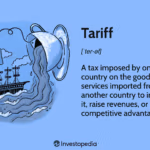How Tariffs Impact Investments

Whether you’re a long-term investor or an active trader, tariffs can have a significant influence on the markets—and your portfolio. As of 2025, global trade tensions continue to ebb and flow, with the U.S., China, and the EU periodically adjusting tariffs in response to political, economic, or strategic shifts. Let’s break down how tariffs can ripple through the economy and impact your investments.
Market Volatility
Tariffs introduce uncertainty, and markets hate uncertainty. When political leaders talk about or implement new tariffs—especially between major economies like the U.S. and China—it can trigger:
Short-term volatility, especially in sensitive sectors like technology, manufacturing, and agriculture.
Capital reallocation, as investors flee to “safe haven” assets like gold, Treasury bonds, or the U.S. dollar.
Recent examples include tariff discussions tied to clean energy technology and semiconductors, which have created big swings in related stocks.
Corporate Profits Could Take a Hit
Companies that rely on global supply chains or export abroad are particularly exposed to tariff-related risks:
Higher input costs: Tariffs on raw materials (like steel, aluminum, lithium, or rare earths) raise production costs, squeezing profit margins.
Reduced foreign demand: If trading partners retaliate, U.S. exporters can see declining sales abroad.
This can directly reduce corporate earnings—putting pressure on stock prices. Sectors most at risk include industrials, automotive, and tech hardware.
Sector Specific Risks
Not all industries are hit equally by tariffs. Here’s how some of the major sectors can be affected:
Auto Industry: Still vulnerable to tariffs on foreign parts and vehicles. Electric vehicles (EVs) in particular depend on global battery supply chains, and tariffs on minerals like cobalt or lithium can create cost spikes.
Tech: Many U.S. tech firms manufacture or source components overseas. The ongoing tech rivalry with China has resulted in chip restrictions and potential retaliatory tariffs that affect companies like Apple, NVIDIA, and Intel.
Agriculture: Still a target during trade disputes. China, for instance, has historically responded to U.S. tariffs by cutting purchases of soybeans, corn, and pork—hitting U.S. farmers hard.
Inflation & Interest Rates
Tariffs increase costs for businesses, and many of those costs are passed on to consumers. That can fuel inflation, especially for:
Consumer electronics
Household goods
Groceries and food packaging
Higher inflation puts pressure on the Federal Reserve to raise interest rates to cool down the economy. And when rates rise:
Borrowing becomes more expensive
Growth stocks typically underperform
Bond prices drop (as yields rise)
In short, tariffs can create a domino effect across multiple asset classes.
Global Economic Tensions
If trade disputes escalate into full-blown trade wars, the impact is broader:
Slower global growth: Multinational companies see shrinking profits, and global supply chains become less efficient.
Strong U.S. dollar: Tariffs (and global uncertainty) can strengthen the dollar, which hurts exporters by making their goods more expensive abroad.
Investors with international exposure or holdings in emerging markets may see higher volatility or underperformance during trade disputes.
What Can Investors Do?
While you can’t control trade policy, you can build a resilient investment strategy:
Diversify across asset classes and sectors.
Monitor exposure to vulnerable industries like manufacturing, tech, or agriculture.
Stay informed on trade developments and adjust positions accordingly.
Consider hedging with assets like gold or Treasury Inflation-Protected Securities (TIPS).
Conclusion:
Tariffs are more than just political tools—they’re economic levers that can reshape markets, impact corporate earnings, and alter investment strategies across the board. As an investor, it’s crucial to stay informed, agile, and diversified. While tariffs may introduce short-term volatility and sector-specific risks, they also create opportunities for those prepared to navigate the shifting landscape. By understanding where and how tariffs exert their influence, you can make more informed decisions that protect your capital and position your portfolio for long-term success.
